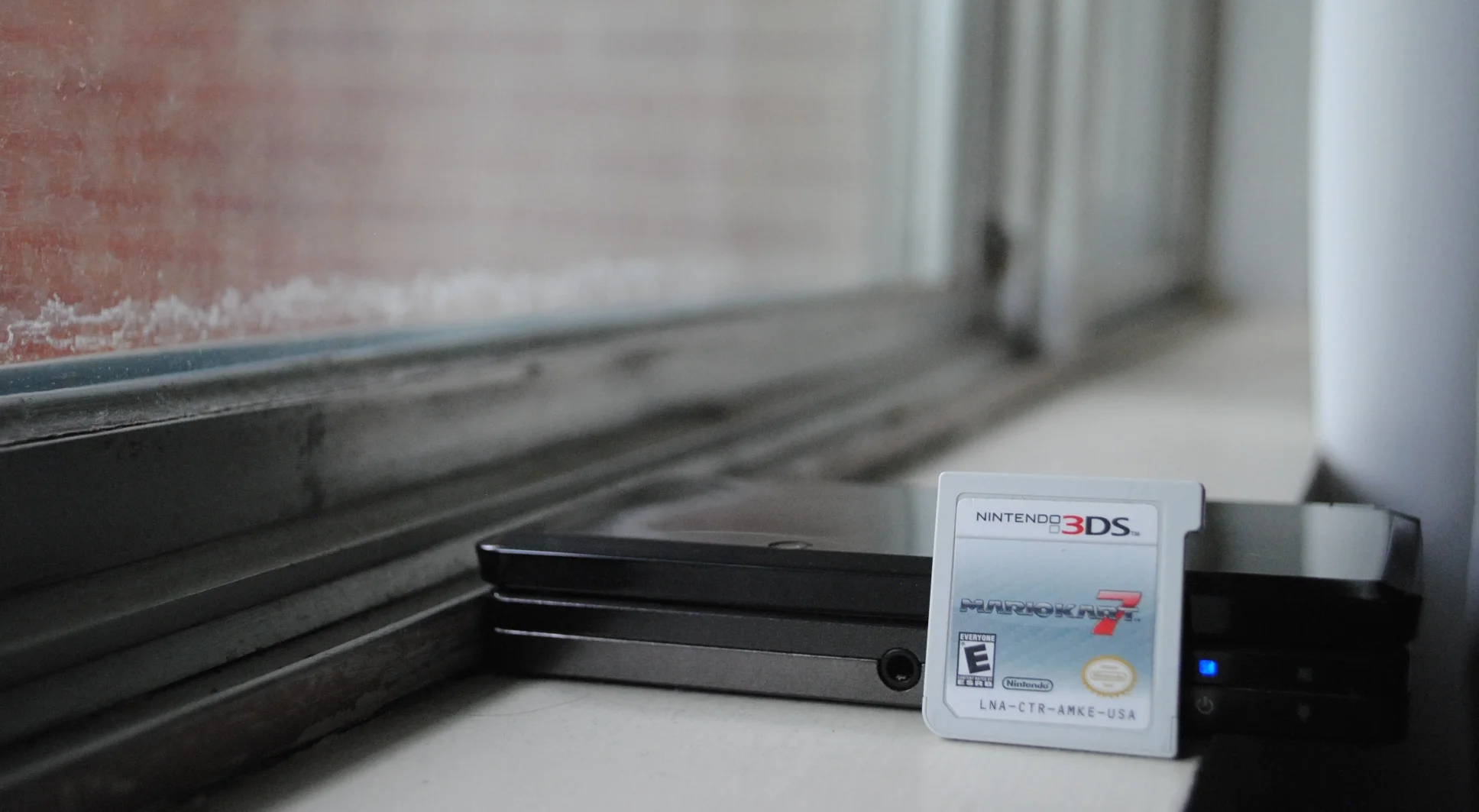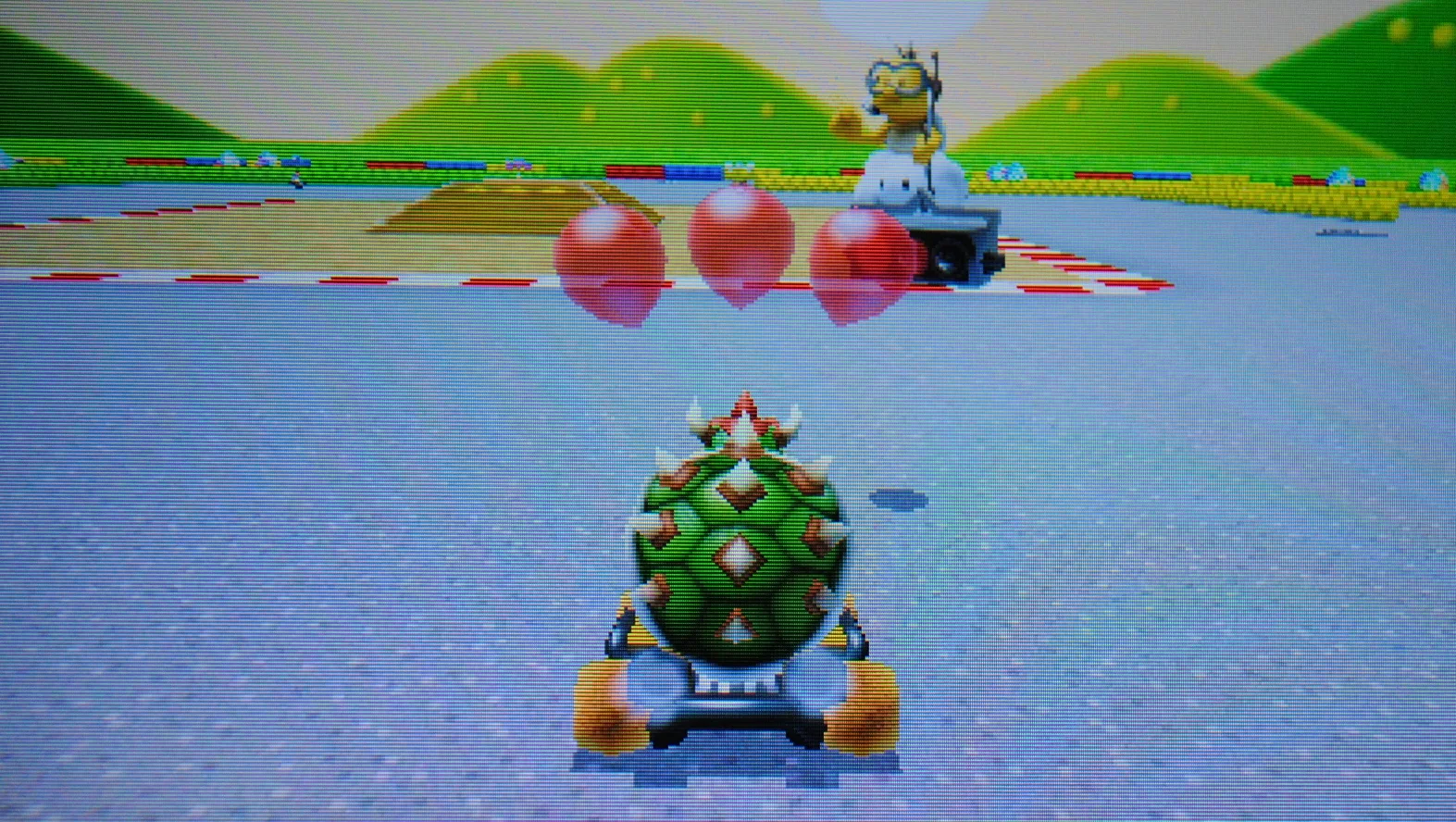I've got to confess that when I started this retrospective series, I thought, "this will be a great opportunity to go back and play all of the Mario Kart games to really get ready for Mario Kart 8." While it's true that I did load up each and every one of the games to play a few laps, most of them were quick hit sessions (mainly to grab some pics for that game's blog post).
What I've really been playing all month is a whole lot of Mario Kart 7 on 3DS. Where the DS iteration laid the groundwork for getting a console-quality kart racer on the go, MK7 takes it up several notches and delivers a beautiful—and very portable—racing experience.
Let's just say that "Lucky Seven" isn't just a new item in this game: it's the perfect subtitle.
But let's back up a minute. If you haven't been following, this is part seven of a seven-part series leading up to Mario Kart 8 on May 30. In it, I'm revisiting each of the main Mario Kart games and sharing some memories, impressions and other fun content celebrating this unique and groundbreaking series. Catch up on the SNES' Super Mario Kart, the N64's Mario Kart 64, the GBA's Mario Kart Super Circuit, the GameCube's Mario Kart Double Dash!!, the Nintendo DS' Mario Kart DS, the Wii's Mario Kart Wii, and then head back here to keep reading!
The 3DS hasn't always had the easiest road, as much as that seems like a distant memory these days with all of the praise and commercial success it's seen in the three years since its launch. No, early in its life, it was a very bumpy road for the handheld device.
After the initial excitement over the glasses-free 3D technology, enthusiasm waned a bit once Nintendo announced the $250 launch price tag. And, despite a lot of third party announcements during the system's E3 reveal, the actual launch lineup of games wasn't quite enough to justify the cost. Games like Pilotwings Resort and Steel Diver were admittedly lesser first-party offerings from Nintendo in an attempt to give third-party games more of the spotlight; the result was a launch that lacked a truly killer app.
The early month's of the system's life proved to be underwhelming in terms of big games or sales figures, leaving many to wonder if the era of the dedicated handheld had indeed passed thanks to the advent of the burgeoning smartphone and tablet market.
Like so many times before, though, Nintendo wasn't content to let the 3DS go down without a fight. In August of 2011, a mere five months after it launched, Nintendo dropped the price by an incredible $80 to a more palatable $170. It was a surprise Hail Mary that caught the industry off-guard in the best of ways. Then, Nintendo kept the momentum going with the first Mario title for the system, Super Mario 3D Land, released in November 2011. It proved that 3D could be a real gameplay mechanic and became the missing killer app that could quickly communicate why players needed a 3DS in their lives. Finally, as if to seal the deal, Mario Kart 7 launched a month later in December 2011 to round out this triple-hit strategy.
It worked, and the 3DS was on the map in a real way. Following the price cut, the system saw a 260% sales increase (source: Wikipedia), and the doom-and-gloom talk that had previously dominated the conversation gave way to StreetPass obsessions and a general aura of excitement around the handheld.
Mario Kart 7 used the increased power of the 3DS to give the game a graphical coat of polish that matched the brilliant gameplay at the series core, all in a portable package. One of the most notable additions to Mario Kart 7 was the introduction of hang-gliding portions mixed into courses. The longer draw distances allowed for big, gorgeous vistas as you floated around hot air balloons, through webs of coins, and past other airborne obstacles. The developers even managed to pepper in moments of gliding in many of the retro courses (even a few of the SNES/GBA ones), helping instill new life in these old favorites.
The character roster is a mixed bag. The starting lineup is almost identical to the original SNES title, with Koopa back (!) instead of Wario, although the more-modern Donkey Kong remains in lieu of Donkey Kong, Jr. From there, a good deal of unlockable characters is available, including Daisy, Wario, Rosalina, Metal Mario, Shy Guy, Honey Queen (from Super Mario Galaxy) Wiggler, Lakitu, and the ability to play as Miis. A few of these, as you may note, are new additions. However, the lack of Birdo is unforgivable.
Cart customization options gave players the ability to tweak their speed, acceleration, weight, handling, and off-road levels; I enjoyed the sense of progression as I unlocked more cart, wheel, and glider components. The only complaint I had with this was that the options impacted the visual look of your kart. So, for example, if you really enjoyed the specs of the flower glider but didn't a giant flower over your kart, you were out of luck.
In a surprising but welcome move, Nintendo brought coins back into the mix for Grand Prix mode. The functionality was similar to past games, with more coins giving you a bit of extra speed (capped at 10). They add a nice bit of strategy to the races as well as providing an extra gameplay tie to the Mushroom Kingdom—and they're back in Mario Kart 8! Other changes included the removal of bikes from Mario Kart Wii and the ability to drive underwater (which was maybe less exciting than hang-gliding but did affect the controls in an interesting way.
Most of the item options from Mario Kart Wii returned, but with three new additions: Fire Flower (allows you to shoot a bunch of fireballs), Super Leaf (a raccoon suit-inspired tail that you can spin around your kart), and Lucky Seven (gives you a veritable smorgasbord of seven items, all of which you can use to inflict mayhem on your fellow racers). With such an impressive array of items, you can have some of the most intense races the series has ever seen. Even so, the balance felt a little fairer than, say, 150cc in Mario Kart Wii, which was more than a little ridiculous.
As with Mario Kart Wii, online was a major focus of Nintendo's strategy with Mario Kart 7. All of the options from its home console predecessor were back, but the addition of racing "communities" that allowed players to have new customization options for like-minded racers. Even better, Nintendo allowed players to share and invite others to their communities by assigning them unique codes that could be exchanged online or through community websites.
The other important connectivity options involved the 3DS-specific SpotPass and StreetPass features. SpotPass allowed the game to get various leaderboard updates whenever your system was hooked into a WiFi hotspot, and the StreetPass implementation allowed you to race against ghost data of Miis of other 3DS owners you passed by with the system in tow. In general, StreetPass became one of the sleeper hit features of the 3DS, and MK7's use of the mode was another great way to feel connected to other players without the pressure or time commitment of direct online play. And, of course, local multiplayer options allow for single or multi-cartridge game sessions, just like Mario Kart DS.
While the game did offer motion control as an option, it was never touted as anything more than a back-of-the-box feature for those curious to enable it. This was an option for a quite unusual first-person view option, which marked the first time a Kart game offered anything other than the standard third-person view. I never used it, and I suspect I was in the majority since character personality is a key ingredient in the series' winning formula.
Thankfully, the focus was all on the 3DS' new Circle Pad, which finally brought analog control to a portable Kart game. Other aspects of the gameplay, like narrower tracks than Mario Kart Wii and the elimination of the potential for a repeat of the "snaking" fiasco from Mario Kart DS, showed that Nintendo had been paying attention to what fans love and hate about the series.
More importantly, though, this was the first Kart game with the potential to be patched, which happened when Nintendo released the version 1.1 update that fixed a batch of track exploits when playing online (source: Mario Wiki). In conservative Nintendo fashion, though, the exploits were left intact for the offline modes. It was good to see Nintendo finally embrace more of the potential offered by internet-connected consoles, even if it took their third opportunity to capitalize on it. Thankfully, the Wii U continued the trend of allowing games to grow and evolve over time.
Mario Kart 7, then, stands as a both a pivotal moment in the 3DS' history but also a genuinely fun game. Despite the fact that it's creeping up on its three year anniversary, it's still in regular rotation on my 3DS and that likely will remain a constant throughout the system's life. It's the perfect companion to the Wii U's Mario Kart 8 so you can always keep those karting skills sharp even when you're not in your living room.
Editor's Note: I realize that I'm posting this on June 1 in a series called "Mario Kart May." If it's any concession, I did start this post in May, but it took longer to finish than I originally anticipated. Still, I figure one day late for the final article isn't the worst thing in the world. Hope you've enjoyed the series!


